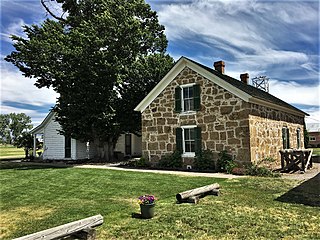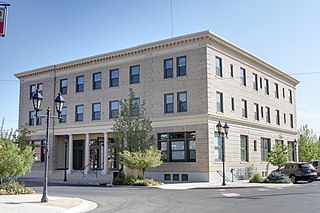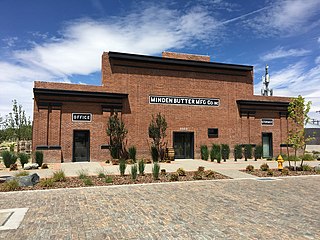
Brandywine Creek is a tributary of the Christina River in southeastern Pennsylvania and northern Delaware in the United States. The Lower Brandywine is 20.4 miles (32.8 km) long and is a designated Pennsylvania Scenic River with several tributary streams. The East Branch and West Branch of the creek originate within 2 miles (3 km) of each other on the slopes of Welsh Mountain in Honey Brook Township, Pennsylvania, about 20 miles (32 km) northwest of their confluence.

The Carrollton Viaduct, located over the Gwynns Falls stream near Carroll Park in southwest Baltimore, Maryland, is the first stone masonry bridge built for railroad use in the United States for the Baltimore and Ohio Railroad, founded 1827, with construction beginning the following year and completed 1829. The bridge is named in honor of Charles Carroll of Carrollton (1737-1832), of Maryland, known for being the last surviving signer of the Declaration of Independence, the only Roman Catholic in the Second Continental Congress (1775-1781), and wealthiest man in the Thirteen Colonies of the time of the American Revolutionary War (1775-1783).

The Thomas Viaduct spans the Patapsco River and Patapsco Valley between Relay, Maryland and Elkridge, Maryland, USA. It was commissioned by the Baltimore and Ohio Railroad (B&O); built between July 4, 1833, and July 4, 1835; and named for Philip E. Thomas, the company's first president.

The Clark Thread Company Historic District, located at 900 Passaic Avenue, East Newark, Hudson County, New Jersey, United States, is a large mill complex. Begun in 1875, it was a major manufacturing site of the Clark Thread Company, the world's leading manufacturer of sewing thread, until 1935. The complex was designated a National Historic Landmark District in 1978 for this association. It now functions as an industrial park housing a diversity of businesses.

This is a list of the National Register of Historic Places listings in Dakota County, Minnesota. It is intended to be a complete list of the properties and districts on the National Register of Historic Places in Dakota County, Minnesota, United States. Dakota County is located in the southeastern part of the U.S. state of Minnesota, bounded on the northeast side by the Upper Mississippi River and on the northwest by the Minnesota River. The locations of National Register properties and districts for which the latitude and longitude coordinates are included below, may be seen in an online map.

This list is of the properties and historic districts which are designated on the National Register of Historic Places or that were formerly so designated, in Hennepin County, Minnesota; there are 172 entries as of January 2020. A significant number of these properties are a result of the establishment of Fort Snelling, the development of water power at Saint Anthony Falls, and the thriving city of Minneapolis that developed around the falls. Many historic sites outside the Minneapolis city limits are associated with pioneers who established missions, farms, and schools in areas that are now suburbs in that metropolitan area.

Allenville Mill Storehouse is a historic mill storehouse at 5 Esmond Street in Esmond, Rhode Island within the town of Smithfield, Rhode Island. The exact date of construction is unknown, but it was built with rubble masonry construction which was typical of mill construction during and after the War of 1812. In 1813, Phillip Allen purchased 4.5 acres of land and constructed a mill on the site, but the first record to specifically refer to the storehouse was an insurance policy from 1836. Allen sold the property in 1857 and it changed ownership several times before it became Esmond Mills in 1906. In 1937, the building was used as a post office and described erroneously as the "Old Allenville Mill". The building has had some alterations to the front door and possibly the addition of a side door, but the interior of the structure was not detailed in the National Register of Historic Places nomination. The Allenville Mill Storehouse was added to the National Register of Historic Places in 1972.

The Sheridan Flouring Mills, also known as the Mill Inn, are an industrial complex in Sheridan, Wyoming. The mills were a major component of the economy of north central Wyoming, providing collection, storage and milling of locally produced wheat and other grains into flour and other milled products. The original mill was established by Captain Scott W. Snively in the early 1890s. The Sheridan Milling and Manufacturing Company was sold to J.W. Denio in 1903, who operated the mill at its location on Broadway Avenue near downtown Sheridan. A catastrophic fire destroyed this mill in 1919, resulting in the purchase of a new location on Coffeen Avenue and construction of a much larger mill.

The Newlin Mill Complex, also referred to as The Newlin Grist Mill, is a water powered gristmill on the west branch of Chester Creek near Concordville, Pennsylvania was built in 1704 by Nathaniel and Mary Newlin and operated commercially until 1941. During its three centuries of operation, the mill has been known as the Lower Mill, the Markham Mill, the Seventeen-O-Four Mill and the Concord Flour Mill. In 1958 the mill property was bought by E. Mortimer Newlin, restored and given to the Nicholas Newlin Foundation to use as a historical park. Water power is still used to grind corn meal which is sold on site. The park includes five historical buildings, which were added to the National Register of Historic Places in 1983, and 150 acres (61 ha) of natural woodland.

Mill City Museum is a Minnesota Historical Society museum in Minneapolis. It opened in 2003 built in the ruins of the Washburn "A" Mill next to Mill Ruins Park on the banks of the Mississippi River. The museum focuses on the founding and growth of Minneapolis, especially flour milling and the other industries that used hydropower from Saint Anthony Falls.

The Dangberg Home Ranch Historic Park is a Douglas County, Nevada, USA, park, preserving one of the state's first ranches.

The Virginia & Truckee (V&T) Railroad Depot of Carson City, Nevada is a historic railroad station that is listed on the U.S. National Register of Historic Places (NRHP). It is significant for its association with the economically important role of the V&T railroad historically in Carson City following discovery of the Comstock Lode mine in 1859. To a lesser degree, according to its NRHP nomination, the depot building is also significant architecturally "as a well-preserved example of a wood-frame passenger depot procured from a railroad company pattern book within the V&T's former sphere of operation."

Farmer's Bank of Carson Valley is a historic bank building located at 1596 Esmeralda Avenue in Minden, Nevada. The building was built in 1909 to house the Farmer's Bank of Carson Valley, which was chartered in the same year. H. F. Dangberg, the founder of Minden, commissioned the building, which was only the second building built in the town. In 1918, the bank outgrew its original building and moved to a larger building across the street. After the bank left the building, it was occupied by the Minden Post Office until 1974. The building has housed a variety of businesses since and is currently occupied by the Bank Parlor and Pub.

Farmer's Bank of Carson Valley is a historic bank building located at 1597 Esmeralda Avenue in Minden, Nevada. The bank was built from 1916 to 1918 to replace the original 1909 bank building, which the Farmer's Bank had outgrown. Prominent Nevada architect Frederic Joseph DeLongchamps designed the building in the Classical Revival style; the bank is one of many Neoclassical structures designed by DeLongchamps in Minden. The bank's design features a cornice with terra cotta tiles and bands, a flat roof with a low parapet, and an entrance portico with Ionic columns. The bank was built for Farmer's Bank organizer H. F. Dangberg, who was also the founder of Minden. The building served as a bank until 1968 and currently houses offices.

The Carson Valley Improvement Club Hall is a historic building located at 1606 Esmeralda Avenue in Minden, Nevada. The building was constructed in 1912 as a meeting hall for the Carson Valley Improvement Club. The two-story building features a variety of brickwork patterns but has an otherwise plain design. The Carson Valley Improvement Club used the building to host both community social events and town meetings. The building has served as the informal seat of government in Minden since its construction; after the Carson Valley Improvement Club moved out in 1920, the Minden Commercial Club and later the Minden Town Board continued to hold government meetings at the building. Though Minden is unincorporated, the groups meeting in this building have acted as local liaisons to Douglas County's government and have helped manage local government services. In addition, the building has continued to house a variety of social events, including concerts, movies, religious services, and basketball games.

The Minden Inn is a historic hotel building located at 1594 Esmeralda Avenue in Minden, Nevada. Built from 1912 to 1916, the building was designed by prominent Nevada architect Frederic Joseph DeLongchamps in the Classical Revival style. The hotel was the largest commercial building in Minden and was operated by H. F. Dangberg, the founder of the town. The inn earned a reputation as "one of the finest small hotels on the West Coast" and was visited by a number of actors and celebrities who passed through Minden on the Virginia and Truckee Railroad. In addition, the hotel included a bar and gambling operations until 1987. The building now houses Douglas County offices.

The Minden Wool Warehouse is a historic warehouse building located at 1615 Railroad Avenue in Minden, Nevada. Built in 1915, the warehouse was designed by prominent Nevada architect Frederic Joseph DeLongchamps. DeLongchamps designed the building for H. F. Dangberg, the founder of Minden, and the warehouse served as the headquarters for Dangberg's Dangberg Land and Livestock Company. Carson Valley farmers used the warehouse to store wool and potatoes before they were shipped out of Minden. The warehouse was later rented to the Minden Flour Company and a local creamery; it is now used as an office building by the Bently Nevada Corporation.

The Minden Butter Manufacturing Company, also known as the Minden Creamery, is a historic creamery building located at 1617 Water St. in Minden, Nevada. Built in 1916, the creamery was designed by noted Nevada architect Frederic Joseph DeLongchamps. The creamery replaced the Minden Butter Manufacturing Company's first building, which was built in 1908, so the company would have space to pasteurize its products. The company sold butter and other produce under the Windmill brand name and eventually became the largest creamery in Nevada. While the company mainly shipped its goods to the San Francisco area, it also sold internationally; the year before the creamery was built, it sent a large shipment of butter to China. The creamery building is now used by Bently Nevada for manufacturing purposes.

The Cheyenne Flour Milling Company, also known as the Standard Oil Company and Salt Creek Freightways, is an early warehouse building in Cheyenne, Wyoming. The structure was built in 1927 to house goods brought to and from Cheyenne by the Union Pacific Railroad in an industrial section of Cheyenne as a flour mill, replacing structures that had performed similar functions since 1915. By 1931 the building was shared by a warehouse for electrical parts for the Mountain States Telephone and Telegraph Company, a potato chip factory and a chemical products company. In 1937-38 the Standard Oil Company started to use the warehouse for bulk petroleum products storage, continuing to 1963. From 1963 the building was used by Salt Creek Freightways, which had shared use from 1936. In 1973 it became a plumbing parts warehouse, and by 2003 was owned and used by a general contractor.

The Missouri Lumber and Mining Company (MLM) was a large timber corporation with headquarters and primary operations in southeast Missouri. The company was formed by Pennsylvania lumbermen who were eager to exploit the untapped timber resources of the Missouri Ozarks to supply lumber, primarily used in construction, to meet the demand of U.S. westward expansion. Its primary operations were centered in Grandin, a company town it built starting c. 1888. The lumber mill there grew to be the largest in the country at the turn of the century and Grandin's population peaked around 2,500 to 3,000. As the timber resources were exhaused, the company had to abandon Grandin around 1910. It continued timber harvesting in other parts of Missouri for another decade. While some of the buildings in Grandin were relocated, many of the remaining buildings were listed on the National Register of Historic Places in 1980 as part of the state's historic preservation plan which considered the MLM a significant technological and economic contributor to Missouri.






















